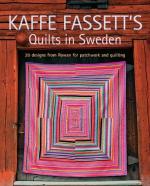|
This section contains 608 words (approx. 3 pages at 300 words per page) |

|
A quilt consists of two layers of fabric—the quilt top and the backing—with a third layer of soft insulating material between them, called the batting. Hand or machine stitching holds the three layers together. A quilt can be "whole cloth" (which means the top is one piece of material) but the more colorful and popular forms are patchwork and appliqué.
In patchwork, small patches are sewn together to form larger patterns, while in appliqué the motifs are stitched onto a background fabric. Patchwork quilts are more likely to be arrangements of geometric figures, such as squares and triangles. Appliqué is more frequently used for freeform or representational designs. In either style, the quiltmaker first completes the top by piecing, then quilts together the sandwich of two layers of fabric with batting in between by stitching through all three layers.
Quilts were made even in the earliest...
|
This section contains 608 words (approx. 3 pages at 300 words per page) |

|


